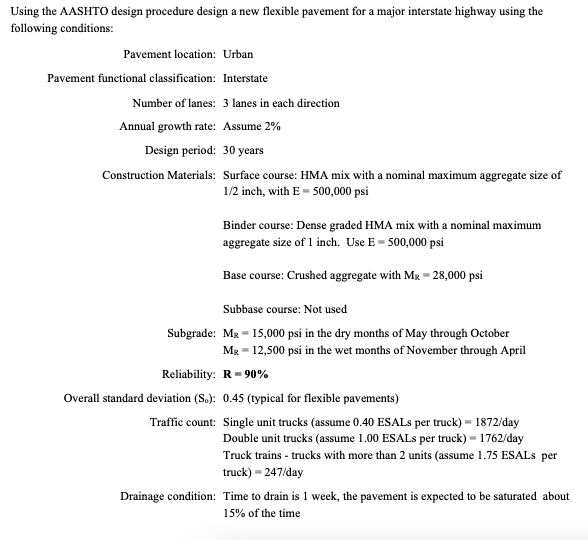Using the AASHTO design procedure design a new flexible pavement for a major interstate highway using the following conditions: Pavement location: Urban Pavement functional classification: Interstate Number of lanes: 3 lanes in each direction Annual growth rate: Assume 2% Design period: 30 years Construction Materials: Surface course: HMA mix with a nominal maximum aggregate size of 1/2 inch, with E- 500,000 psi Binder course: Dense graded HMA mix with a nominal maximum aggregate size of 1 inch. Use E 500,000 psi Base course: Crushed aggregate with MR -28,000 psi Subbase course: Not used Subgrade: MR 15,000 psi in the dry months of May through October Mx 12,500 psi in the wet months of November through April Reliability: R 90% Overall standard deviation (S.): 0.45 (typical for flexible pavements) Traffic count: Single unit trucks (assume 0.40 ESALS per truck) - 1872/day Double unit trucks (assume 1.00 ESALS per truck) - 1762/day Truck trains - trucks with more than 2 units (assume 1.75 ESALS per truck)-247/day Drainage condition: Time to drain is 1 week, the pavement is expected to be saturated about 15% of the time
Using the AASHTO design procedure design a new flexible pavement for a major interstate highway using the following conditions: Pavement location: Urban Pavement functional classification: Interstate Number of lanes: 3 lanes in each direction Annual growth rate: Assume 2% Design period: 30 years Construction Materials: Surface course: HMA mix with a nominal maximum aggregate size of 1/2 inch, with E- 500,000 psi Binder course: Dense graded HMA mix with a nominal maximum aggregate size of 1 inch. Use E 500,000 psi Base course: Crushed aggregate with MR -28,000 psi Subbase course: Not used Subgrade: MR 15,000 psi in the dry months of May through October Mx 12,500 psi in the wet months of November through April Reliability: R 90% Overall standard deviation (S.): 0.45 (typical for flexible pavements) Traffic count: Single unit trucks (assume 0.40 ESALS per truck) - 1872/day Double unit trucks (assume 1.00 ESALS per truck) - 1762/day Truck trains - trucks with more than 2 units (assume 1.75 ESALS per truck)-247/day Drainage condition: Time to drain is 1 week, the pavement is expected to be saturated about 15% of the time
Traffic and Highway Engineering
5th Edition
ISBN:9781305156241
Author:Garber, Nicholas J.
Publisher:Garber, Nicholas J.
Chapter19: Design Of Flexible Highway Pavements
Section: Chapter Questions
Problem 16P
Related questions
Question
100%
please help with transportation problem. please make sure it is correct. Will thumbs up if correct.

Transcribed Image Text:Using the AASHTO design procedure design a new flexible pavement for a major interstate highway using the
following conditions:
Pavement location: Urban
Pavement functional classification: Interstate
Number of lanes: 3 lanes in each direction
Annual growth rate: Assume 2%
Design period: 30 years
Construction Materials: Surface course: HMA mix with a nominal maximum aggregate size of
1/2 inch, with E- 500,000 psi
Binder course: Dense graded HMA mix with a nominal maximum
aggregate size of 1 inch. Use E 500,000 psi
Base course: Crushed aggregate with MR -28,000 psi
Subbase course: Not used
Subgrade: MR 15,000 psi in the dry months of May through October
Mx 12,500 psi in the wet months of November through April
Reliability: R 90%
Overall standard deviation (S.): 0.45 (typical for flexible pavements)
Traffic count: Single unit trucks (assume 0.40 ESALS per truck) - 1872/day
Double unit trucks (assume 1.00 ESALS per truck) - 1762/day
Truck trains - trucks with more than 2 units (assume 1.75 ESALS per
truck)-247/day
Drainage condition: Time to drain is 1 week, the pavement is expected to be saturated about
15% of the time
Expert Solution
This question has been solved!
Explore an expertly crafted, step-by-step solution for a thorough understanding of key concepts.
This is a popular solution!
Trending now
This is a popular solution!
Step by step
Solved in 2 steps with 6 images

Recommended textbooks for you

Traffic and Highway Engineering
Civil Engineering
ISBN:
9781305156241
Author:
Garber, Nicholas J.
Publisher:
Cengage Learning

Traffic and Highway Engineering
Civil Engineering
ISBN:
9781305156241
Author:
Garber, Nicholas J.
Publisher:
Cengage Learning